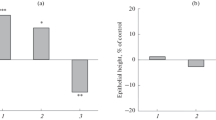Summary
An investigation of the pathomechanism of experimental porphyria cutanea tarda using hexachlorobenzene(HCB)-treated mice and rats was carried out. Male Wistar rats proved to be superior to CF I-mice for this purpose. Three different degrees of experimental porphyria were produced by different dose-schedules. The so-called “latent HCB-porphyria“ of the rat was found to be most suitable and was produced by feeding 0.2% HCB on three successive days per week. This caused a slight increase in porphyrin-excretion for a considerable length of time. Additional factors produced more severe alterations.
Zusammenfassung
Als Basis für eine größere Untersuchungsreihe zum Auffinden von Kausalfaktoren, die bei der Entstehung der Porphyria cutanea tarda des Menschen eine Rolle spielen könnten, wurden Versuche mit dem als Porphyrogen bekannten Hexachlorbenzol an Mäusen und Ratten durchgeführt. Dabei ergab sich, daß männliche Wistar-Ratten für diesen Zweck wesentlich besser geeignet sind als CF I-Mäuse. Mit Hilfe einer unterschiedlichen Dosierung des 0,2% Hexachlorbenzol enthaltenden Futters ließen sich bei Ratten drei Grade der experimentellen Porphyrie erzeugen. Unter diesen ist die leichteste, die „latente HCB-Porphyrie der Ratte“ für den vorgesehenen Zweck am besten geeignet. Durch Verfütterung von 0,2% HCB an drei aufeinanderfolgenden Tagen je Woche tritt nämlich nur ein geringer Anstieg der Porphyrin-Ausscheidung ein, der über einen genügend langen Zeitraum annähernd konstant bleibt, durch andere Faktoren aber signifikant verstärkt werden kann.
Similar content being viewed by others
Literatur
Arutjunow, W. I., Golemba, P. I.: Klinik und Therapie der bullösen Form der Porphyrinurie. Klin. Med. (Mosk.)35, 115–118 (1957); ref. Dtsch. med. Wschr.83, 230 (1958).
Blaich, R.: Untersuchung zur experimentellen chronisch-hepatischen Porphyrie bei Mäusen. Diss., Düsseldorf 1970.
Cam, C., Nigogosyan, G.: Acquired toxic Porphyria cutanea tarda due to Hexachlorobenzene. J. Amer. med. Ass.183, 88–91 (1963).
Doss, M.: Zur Wirkung von Oestradiol und Progesteron auf die Porphyrin-Synthese in Leberzellkulturen. Klin. Wschr.47, 228–229 (1969).
Friesen, M.: Untersuchungen zur experimentellen chronisch-hepatischen Porphyrie bei Ratten. Diss., Düsseldorf 1971.
Goerz, G., Ippen, H., Hüttenhain, S.: Quantitativer und qualitativer Prophyrin-Gehalt der Harderschen Drüse bei Ratten. In Vorbereitung.
Granick, S.: The induction in vitro of the synthesis of deltaaminolevulinic acid synthetase in chemical porphyria: A response to certain drugs, sex hormones and foreign chemicals. J. biol. Chem.241, 1359–1375 (1966).
Haeger-Aronson, B.: Experimental disturbance of prophyrin metabolism and of liver catalase activity in guinea pigs and rabbits. Acta pharmacol. (Kbh.)21 105–115 (1964).
Ippen, H.: Allgemeinsymptome der späten Hautporphyrie (Porphyria cutanea tarda) als Hinweise für deren Behandlung. Dtsch. med. Wschr.86, 127–133 (1961).
Ippen, H.: Kausalfaktoren der Porphyria cutanea tarda. Derm. Wschr.153, 1351–1356 (1967).
Kalivas, J. T., Pathak, M. A., Fitzpatrick, T. B.: Phlebotomy and iron overload in porphyria cutanea tarda. Lancet1969 I, 1184–1187.
Matteis, F. de: Disturbances of liver porphyrin metabolism caused by drugs. Pharmacol. Rev.19, 523–557 (1967).
Matteis, F. de, Prior, B. E., Rimington, C.: Nervous and biochemic disturbances following hexachlorobenzene intoxication. Nature (Lond.)191, 363–366 (1961).
Ockner, R. K., Schmid, R.: Acquired porphyria in man and rat due to hexachlorobenzene intoxication. Nature (Lond.)189, 499 (1961).
Pathak, M. A., Burnett, J. W.: The porphyrin content of skin. J. invest. Derm.43, 119–120 (1964).
Pathak, M. A., Burnett, J. W.: The intracellular localization of porphyrins. J. invest. Derm.43, 421–427 (1964).
Pieper, J. C.: Untersuchung der Porphyrin-Ausscheidung bei Arsenobenzolbehandelten Syphilitikern. Diss., Düsseldorf 1964.
Raab, W., Pietschmann, H., Hartl, O.: Serumenzymaktivitäten bei der experimentellen Porphyrie der Ratte. Arzneimittel-Forsch.17, 985–986 (1967).
Rifkind, A. B., Gilette, P. N., Song, C. S., Kappas, A.: Induction of hepatic delta-ALA-synthetase by oral contraceptive steroids. J. clin. Endocr.30, 330–335 (1970).
Rollier, R., Deleuze, G.: La porphyrie cutanée tardive. Maroc. méd.36, 798–815 (1957).
Schmid, R.: Cutaneous porphyria in turkey. New Engl. J. Med.263, 397–398 (1960).
Sveinsson, S. L., Rimington, C., Barnes, H. D.: Complete prophyrin analysis of pathological urines. Scand. J. clin. Lab. Invest.1, 2–11 (1949).
Author information
Authors and Affiliations
Additional information
Dem Andenken des unermüdlichen Förderers der wissenschaftlichen Forschung, Staatssekretär Dr. L. Brandt, gewidmet.
Rights and permissions
About this article
Cite this article
Ippen, H., Aust, D. Klinisch-experimentelle untersuchungen zur entstehung der porphyrien. Arch. Derm. Forsch. 245, 110–124 (1972). https://doi.org/10.1007/BF00584515
Received:
Issue Date:
DOI: https://doi.org/10.1007/BF00584515




